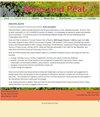Cold storage as a method for the long-term preservation of tropical dissolved organic carbon (DOC)
IF 1.5
4区 环境科学与生态学
Q4 ENVIRONMENTAL SCIENCES
引用次数: 48
Abstract
Fluvial fluxes of dissolved organic carbon (DOC) may represent an important loss for terrestrial carbon stores in the tropics. However, there is currently limited guidance on the preservation of tropical water samples for DOC analysis. Commonly employed preservation techniques such as freezing or acidification can limit degradation but may also alter sample properties, complicating DOC analysis. We examined the effects of cold storage at 4 °C on DOC concentration and quality in water samples collected from a tropical peat catchment. Samples were stored in the dark at 4 °C for periods of 6–12 weeks. Freeze/thaw experiments were also made. Mean DOC concentrations in samples stored for six weeks at 4 °C were 6.1 % greater than in samples stored at ambient room temperature (33 °C) over the same period. Changes in DOC concentrations, in two sample sets, during cold storage were 2.25 ± 2.9 mg L-1 (8 %) to 2.69 ± 1.4 mg L-1 (11 %) over a 12-week period. Freeze/thaw resulted in alterations in the optical properties of samples, and this in turn altered the calculated DOC concentrations by an average of 10.9 %. We conclude that cold storage at 4 °C is an acceptable preservation method for tropical DOC water samples, for moderate time periods, and is preferable to freezing or storage at ambient temperatures.冷藏作为热带溶解有机碳(DOC)的长期保存方法
溶解有机碳(DOC)的河流通量可能是热带陆地碳储量的重要损失。然而,目前关于保存热带水样以进行DOC分析的指导有限。常用的保存技术,如冷冻或酸化可以限制降解,但也可能改变样品的性质,使DOC分析复杂化。我们研究了4°C冷藏对从热带泥炭集水区收集的水样中DOC浓度和质量的影响。样品在4°C的暗箱中保存6-12周。并进行了冻融实验。在4°C下保存6周的样品的平均DOC浓度比在室温(33°C)下保存的样品同期高6.1%。在12周的冷藏期间,两组样品的DOC浓度变化为2.25±2.9 mg L-1(8%)至2.69±1.4 mg L-1(11%)。冻结/解冻导致样品光学性质的改变,这反过来又使计算的DOC浓度平均改变10.9%。我们得出的结论是,4°C的冷藏是热带DOC水样的一种可接受的保存方法,保存时间适中,比冷冻或在环境温度下储存更可取。
本文章由计算机程序翻译,如有差异,请以英文原文为准。
求助全文
约1分钟内获得全文
求助全文
来源期刊

Mires and Peat
ENVIRONMENTAL SCIENCES-
CiteScore
2.30
自引率
16.70%
发文量
0
审稿时长
33 weeks
期刊介绍:
Mires and Peat is a peer-reviewed internet journal focusing specifically on mires, peatlands and peat. As a truly “free-to-users” publication (i.e. NO CHARGES to authors OR readers), it is immediately accessible to readers and potential authors worldwide. It is published jointly by the International Peatland Society (IPS) and the International Mire Conservation Group (IMCG).
Mires and Peat is indexed by Thomson Reuters Web of Science (2017 Impact Factors: 1.326 [two-year] and 1.638 [five-year]), Elsevier Scopus, EBSCO Environment Complete, CABI Abstracts, CSA Proquest (including their Aquatic Science and Fisheries Abstracts ASFA, Ecology, Entomology, Animal Behavior, Aqualine and Pollution databases) and Directory of Open Access Journals (DOAJ). Mires and Peat also participates in the CABI Full Text Repository, and subscribes to the Portico E-journal Preservation Service (LTPA).
Mires and Peat publishes high-quality research papers on all aspects of peatland science, technology and wise use, including:
ecology, hydrology, survey, inventory, classification, functions and values of mires and peatlands;
scientific, economic and human aspects of the management of peatlands for agriculture, forestry, nature conservation, environmental protection, peat extraction, industrial development and other purposes;
biological, physical and chemical characteristics of peat; and
climate change and peatlands.
Short communications and review articles on these and related topics will also be considered; and suggestions for special issues of the Journal based on the proceedings of conferences, seminars, symposia and workshops will be welcomed. The submission of material by authors and from countries whose work would otherwise be inaccessible to the international community is particularly encouraged.
 求助内容:
求助内容: 应助结果提醒方式:
应助结果提醒方式:


